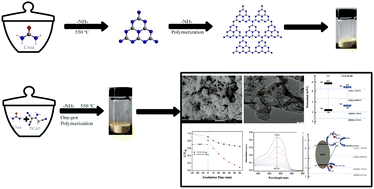One step synthesis of efficient photocatalysts by TCAP doped g-C3N4 for enhanced visible-light photocatalytic activity†
Abstract
This paper describes a simple one-pot method for the synthesis of a new non-metal-doped graphite carbon nitride (CN/TCAP) by thermal condensation of 2-amino-1,1,3-tricyano-1-propene (TCAP) and urea. A small amount of TCAP is added into urea as a precursor during thermal polymerization. The material retains the original structure of g-C3N4, exhibits significantly enhanced visible light capture, and promotes the separation and transfer of photoexcited charge carriers. The CN/TCAP-100 catalyst degrades 10 mg L−1 Orange II (OR-II) in 60 min at a photocatalytic rate of 0.038 min−1, which is almost 6.55 times the photocatalytic rate of pure g-C3N4. The CN/TCAP-X has a high visible light-driven oxidation activity due to its porous morphology and unique electrical structure. The porous structure of CN/TCAP-X provides more active sites for the adsorption and degradation of contaminants. In addition, the copolymerization of TCAP helps extend the range of light absorption to 561 nm, improve the separation of charge carriers, and change the position of the conduction and valence bands. The edge of the valence band moves from 1.94 eV to 1.78 eV due to the doping of TCAP. Trapping experiments showed that superoxide radicals play a major role in the photocatalytic degradation of OR-II on CN/TCAP-100.



 Please wait while we load your content...
Please wait while we load your content...